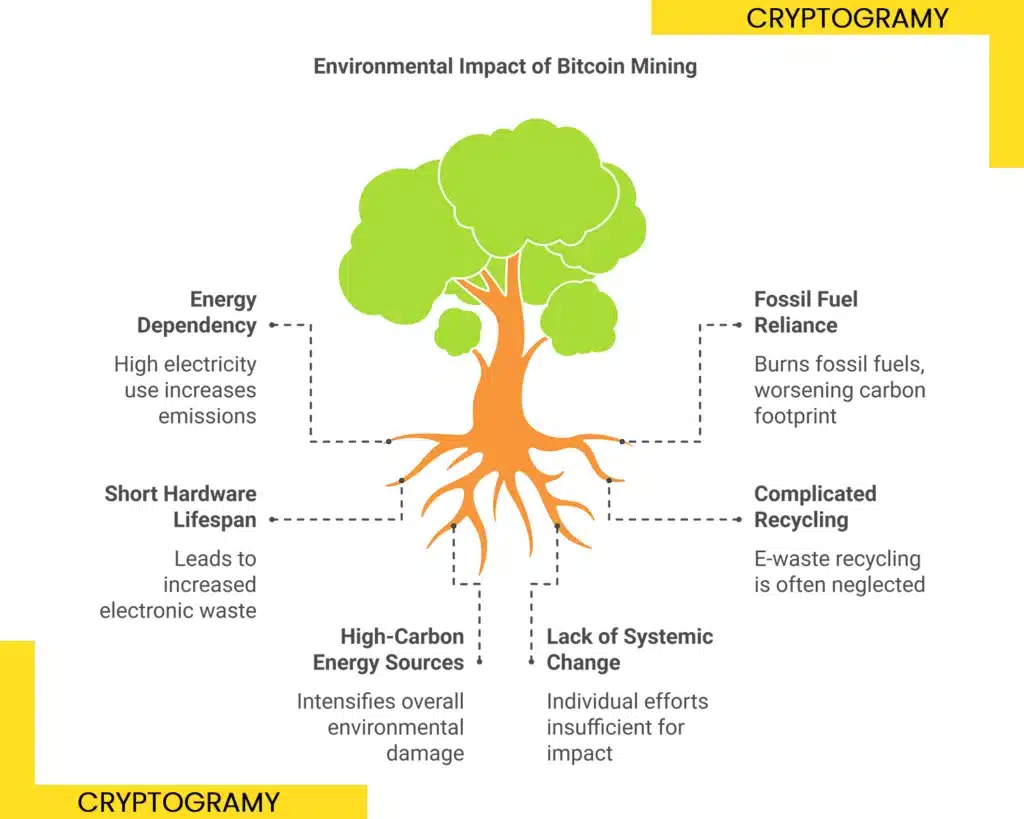Bitcoin mining has long been a hot button topic, but here at the tail end of 2025, its environmental impact has become something we cannot ignore. For crypto fans, climate activists, and technology entrepreneurs, the problems and promises of cleaner Bitcoin mining are top of mind. As energy consumption soars and debates rage, understanding the overlap between Bitcoin mining and the environment is important.
This blog detailed analysis into the Bitcoin mining industry in 2025 that covers its environmental concerns, technological advancements, and efforts to become greener. By the end, you’ll have considered both sides of the cryptocurrency debate and its environmental implications.
What Exactly Is Bitcoin Mining, and Why Does It Impact the Environment?
Bitcoin mining is the process of verifying and adding transactions to the blockchain. It involves solving complex mathematical problems using advanced computers, which requires substantial computational power and energy.
Why does this matter? The electricity used for mining often comes from non-renewable sources, which contribute significantly to carbon emissions. Coupled with electronic waste from outdated mining equipment, Bitcoin mining poses an undeniable challenge to sustainability.
Simply put, every Bitcoin transaction or newly minted coin comes with a hidden environmental cost. But what does Bitcoin mining look like in 2025, and how has it evolved?
Bitcoin Mining in 2025: Current Practices and Trends
Skip ahead to the year 2025 and Bitcoin mining looks nothing like before. Data centers have sprung up around the world, and the profits from certifying transactions have also been spread worldwide. The bulk of mining has now come to be centralized in regions that can offer cheap electricity — chiefly China, the United States and some European countries.
Big news for 2025 includes the increase of renewable energy sources being adopted in mining operations. Some miners have powered their rigs through solar farms, hydroelectric dams and wind turbines. And regulatory pressure nudges the industry toward transparency in energy sourcing and emissions reporting.
But even as we made progress, challenges remain and environmental damage is still substantial.
Key Statistics in 2025:
- Bitcoin mining globally consumes more energy annually than in some small countries.
- Over 65% of total mining operations rely on fossil fuel-based electricity.
- E-waste from outdated mining rigs continues to rise, up to thousands of metric tons yearly.
Clearly, the environmental toll of Bitcoin mining demands further action.
The Environmental Concerns of Bitcoin Mining
Energy Consumption
Bitcoin mining’s dependency on electricity is its most pressing environmental issue. Most of the world’s electricity generation still relies on burning fossil fuels, which releases greenhouse gases into the atmosphere.
To grasp the scale, the energy consumption from Bitcoin mining in 2025 far outpaces that of household devices or small manufacturing industries. This results in a massive carbon footprint that demands urgent mitigation.
E-Waste
Unlike your average laptop or smartphone, Bitcoin mining hardware—such as ASICs (Application-Specific Integrated Circuits)—has a shortened life cycle. With each technological advancement, outdated equipment is discarded, contributing to mountains of electronic waste globally.
The challenge? Recycling e-waste is complicated and often not prioritized.
Carbon Footprint
Mining operations that rely on coal or other high-carbon energy sources significantly compound Bitcoin’s environmental problems—the more energy-intensive the mining process, the greater the emissions.
Fighting this trend requires not just individual shifts but systemic industry change.

Technological Innovations in Bitcoin Mining to Reduce Environmental Impact
Luckily, innovation is driving change—starting with new mining protocols and hardware improvements.
Efficiency in ASIC Mining
Modern ASIC rigs in 2025 are achieving unprecedented energy efficiency compared to their predecessors. Newer models consume less electricity while delivering higher hash rates, which means fewer carbon emissions per processed block.
Modular Mining Rigs
Some companies have introduced modular rigs that can be easily upgraded instead of discarded, directly addressing the e-waste problem. By replacing only specific components, miners dramatically extend their hardware’s life cycle.
Liquid Cooling Systems
To reduce energy-intensive cooling methods, many data centers now employ liquid immersion cooling systems, which are cleaner and more sustainable. This innovation ensures mining rigs operate at optimal efficiency while saving electricity.
Technological advancements are lighting the path to a greener mining future. But they’re not the whole solution.
Renewable Energy’s Role in Sustainable Bitcoin Mining
One of the most promising developments in 2025 is using renewable energy to power mining operations.
- Solar Energy: Solar farms in sunny regions have become popular for miners looking to cut costs and emissions.
- Hydropower: Dams provide energy for large mining operations, especially in rural areas where hydropower is accessible and cheap.
- Wind Energy: Offshore wind farms contribute to powering decentralized mining clusters.
Miners taking such steps aren’t only reducing their environmental impact—many are also cutting operational costs and boosting their public image. Still, achieving sustainable Bitcoin mining on a global scale requires more than individual initiatives.
Community and Industry Efforts to Combat Environmental Challenges
The Bitcoin mining ecosystem includes not just individual miners but also corporations, governments, and environmental organizations:
Government Regulations
Governments are increasingly involved in monitoring and regulating Bitcoin mining emissions. Some regions have introduced green mining subsidies and incentives for renewable energy adoption.
Industry Collaboration
Networks of miners are pooling resources to create decentralized mining farms powered by renewables. These collaborations help smaller miners compete with more extensive operations while maintaining sustainability.
Public Awareness Campaigns
Within the larger crypto community, environmental awareness campaigns—such as Carbon Neutral BTC—highlight the broader impact of Bitcoin mining. These efforts are vital in driving more accountability across the space.
Collaboration at the community and industry levels is necessary to address the challenges at scale.
What’s Next? A Look into the Future of Bitcoin Mining
What does the future hold for Bitcoin mining’s environmental footprint? Here are some predictions:
Wide-scale Implementation of Alternative Protocols
Proof-of-work (PoW) mining, which is energy-intensive, may soon be complemented—or replaced—by alternatives like Proof-of-Stake (PoS) or other hybrid protocols.
Energy Innovation Breakthroughs
Expect breakthroughs in renewable energy technology, making green Bitcoin mining more accessible to smaller operations.
Stronger Regulations
Tighter government regulations worldwide are expected, likely focused on emissions caps and mandatory renewable energy use.
A Shift Away from Centralization
Some predict a future where mining becomes more decentralized, encouraging individuals and small businesses to participate using smaller, energy-efficient rigs.
Innovation shows promise, but as these solutions mature, they must be implemented at scale.
Building a Sustainable Future for Bitcoin Mining
That dynamic was reflected in Bitcoin mining in 2025. On one side, it energizes a whole decentralized financial system that emphasizes innovation and accessibility; on the other, it creates clear environmental problems.
The bright side is there are some solutions. But every day is a day of progress, from the adoption of renewable energy sources to technological innovation and local initiatives.
As a cryptocurrency enthusiast, environmentalist or technological visionary, you are central to what comes next. We must find a way to balance the boundless potential of blockchain technology with the ecological responsibility it requires.
Interested in learning more about Bitcoin mining’s sustainability or the potential role renewable energy can play? Be aware — the season to construct greener systems begins here.


